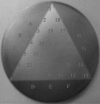Combinatorial growth of oxide nanoscaffolds and its influence in osteoblast cell adhesion
- PMID: 22670064
- PMCID: PMC3365913
- DOI: 10.1063/1.4714727
Combinatorial growth of oxide nanoscaffolds and its influence in osteoblast cell adhesion
Abstract
We report a novel method for high-throughput investigations on cell-material interactions based on metal oxide nanoscaffolds. These scaffolds possess a continuous gradient of various titanium alloys allowing the compositional and morphological variation that could substantially improve the formation of an osseointegrative interface with bone. The model nanoscaffold has been fabricated on commercially pure titanium (cp-Ti) substrate with a compositional gradients of tin (Sn), chromium (Cr), and niobium (Nb) deposited using a combinatorial approach followed by annealing to create native oxide surface. As an invitro test system, the human fetal osteoblastic cell line (hFOB 1.19) has been used. Cell-adhesion of hFOB 1.19 cells and the suitability of these alloys have been evaluated for cell-morphology, cell-number, and protein adsorption. Although, cell-morphology was not affected by surface composition, cell-proliferation rates varied significantly with surface metal oxide composition; with the Sn- and Nb-rich regions showing the highest proliferation rate and the Cr-rich regions presenting the lowest. The results suggest that Sn and Nb rich regions on surface seems to promote hFOB 1.19 cell proliferation and may therefore be considered as implant material candidates that deserve further analysis.
Figures




Similar articles
-
Addition of Sn to TiNb alloys to improve mechanical performance and surface properties conducive to enhanced cell activity.Mater Sci Eng C Mater Biol Appl. 2020 Oct;115:110839. doi: 10.1016/j.msec.2020.110839. Epub 2020 Mar 12. Mater Sci Eng C Mater Biol Appl. 2020. PMID: 32600675
-
Comprehensive Characterization of Titania Nanotubes Fabricated on Ti-Nb Alloys: Surface Topography, Structure, Physicomechanical Behavior, and a Cell Culture Assay.ACS Biomater Sci Eng. 2020 Mar 9;6(3):1487-1499. doi: 10.1021/acsbiomaterials.9b01857. Epub 2020 Feb 18. ACS Biomater Sci Eng. 2020. PMID: 33455386
-
Surface characteristics and protein adsorption on combinatorial binary Ti-M (Cr, Al, Ni) and Al-M (Ta, Zr) library films.J Biomed Mater Res A. 2010 Feb;92(2):521-32. doi: 10.1002/jbm.a.32398. J Biomed Mater Res A. 2010. PMID: 19235218
-
Wear-resistant, hemocompatible Ti-Nb-Zr and Zr-Nb alloys to improve blood pump design and performance.Artif Organs. 1996 Jun;20(6):513-22. Artif Organs. 1996. PMID: 8817948 Review.
-
Binary titanium alloys as dental implant materials-a review.Regen Biomater. 2017 Oct;4(5):315-323. doi: 10.1093/rb/rbx027. Epub 2017 Sep 23. Regen Biomater. 2017. PMID: 29026646 Free PMC article. Review.
Cited by
-
Study on the influence of scaffold morphology and structure on osteogenic performance.Front Bioeng Biotechnol. 2023 Mar 27;11:1127162. doi: 10.3389/fbioe.2023.1127162. eCollection 2023. Front Bioeng Biotechnol. 2023. PMID: 37051275 Free PMC article. Review.
References
-
- Hanawa T., in The Bone-Biomaterial Interface, edited by Davies J. E. (University of Toronto Press, Toronto, 1991), pp. 49–61.
Grants and funding
LinkOut - more resources
Full Text Sources
Research Materials
Miscellaneous
